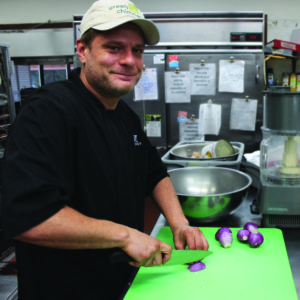Announcements

Feeding children is no easy task and school menus typically reflect challenges that range from picky eaters to high food costs to kitchen staffing. School cafeterias are charged with providing healthy, balanced meals that kids will eat but finding a menu that addresses multiple objectives takes determination and know-how.

Green Chimneys Chef Ken Klepack
Over a year ago, Executive Director Ed Placke and Chef Ken Klepack started to talk about food as medicine, and its importance at a facility that serves three meals a day to children who have a range of health issues. A healthy diet is crucial to a child’s growth and development. It impacts their ability to learn, manage emotions, and feel their best.
In further educating himself about healthy foods, dangerous ingredients and kitchen efficiency, a concerted effort to revise – and revitalize – Green Chimneys’ menus was born. Ken began with a thorough inventory of all food items in stock. He cleared out those with unhealthy or questionable ingredients, or that were overly processed. “I was amazed at the prevalence of nearly inedible substances in so many of the foods we regularly used,” recalls Ken.
Green Chimneys students were not happy at first. Crystal Light drink mix was a popular mealtime beverage as were a couple of sugared cereals. Ed and Ken spent time polling and talking with students as changes were introduced, gauging their reactions and seeing where improvements, or partial compromises, could be made.
The earliest menu modifications included:
At present, 99% of the kitchen’s cooking is from scratch and food purchase guidelines include “No artificial sweeteners, “No preservatives or dyes,” and “No fillers or non-food ingredients.” There is also a goal of reduced environmental impact so local produce is used as often as possible; cereal is served in bulk; and individual milk cartons have been eliminated.
“My mission is to help our students – and staff – eat as healthfully as possible each day and hopefully, expand their palettes and willingness to try new foods, as well,” says Ken. “Food can be medicine but is also meant for our enjoyment!”

Crowned the best for falconry in medieval times, gyrfalcons were once reserved for kings. As the largest falcon in the world, with exquisite plumage ranging from bright white to deep charcoal, gyrs are revered for their powerful skill of flight. Their long wings make hunting waterfowl from 3,000-feet-high a feasible and fantastical feat. This falcon was flown in the sport of falconry for several years.